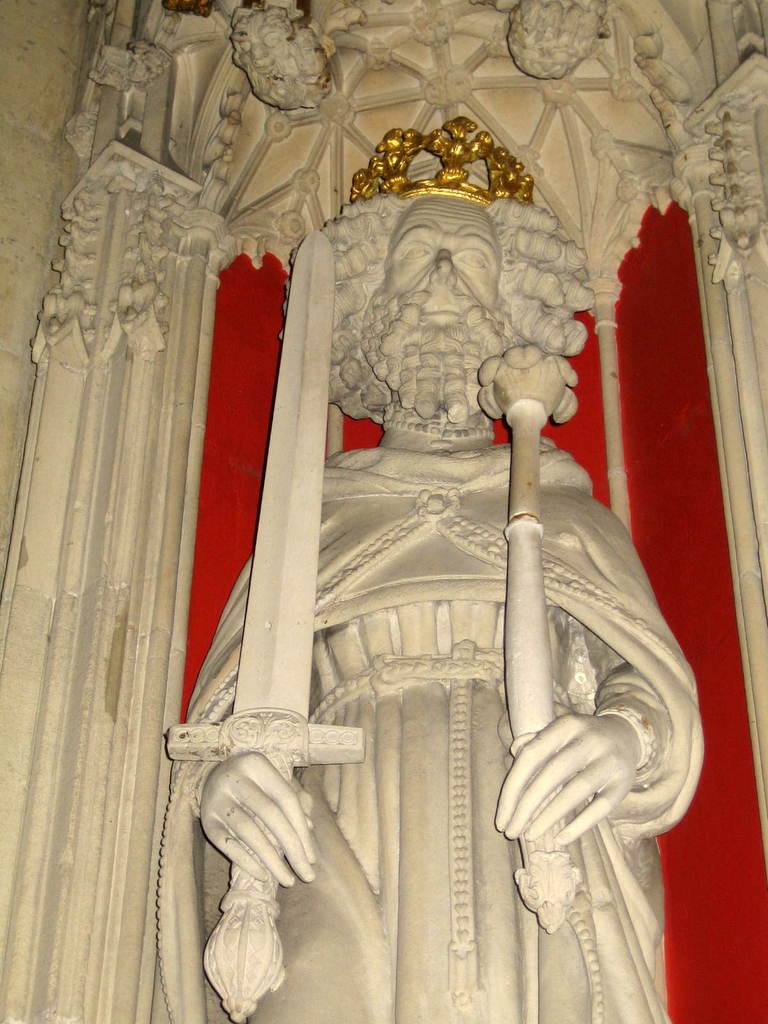|
|
York Minster: Choir Screen
|
|
|
York Minster: Choir Screen
|
One of the finest bits of history (and sculpture) remaining in York Minster is the screen that separates the transept and nave areas from the choir (Quire). Many medieval cathedrals separate their naves (often used for secular purposes like selling wine) from the inner sanctum of the choir dedicated to the religious services -- a church within a cathedral, so to speak.
York's late 15th century "Kings' screen" is magnificent but asymmetrical as sculptor William Hyndeley had to accommodate the 15 nearly-life-size statues of English kings from William the Conqueror to the time of the screen creation in the reign of the child king Henry VI. Most likely, Henry VI ruined the symmetry when his statue was added at the last minute when Henry V died unexpectedly in 1422.
Choir screen symmetry was not all that Henry VI damaged. At age nine months, he was tagged as an early bloomer (if you strain, you might get a bad pun about the War of Roses) when his father (Henry V) died. Henry VI was crowned King of England before his 8th birthday and King of France about two years later. (He did not exercise power until he reached age 16 and, not coincidentally, his mother died.) He was thought to be too spiritual a man to be an effective king. (Americans seemed to have reversed that trend lately even though they still expect presidents to inherit thrones from their fathers.) Despite his spirituality, Henry reigned during the War of Roses, one of the bloodiest in English history. Henry himself was insane nearly the last two decades of his life and was murdered. Was it easier to tell if the head of state was insane before politicians invented spin?) Henry VI's statue on the choir screen is not the original which was defaced many times, replaced with one of James I, and finally replaced, hopefully for good, in 1810. Seems like Henry VI had trouble with endings even though he was well begun.
Perhaps the rest of the statues survived by being more historical than Catholic. The most likely king destroyers, the Parliamentarians who defeated took York during the English Civil War, were forbidden to ransack the cathedral as their commander was from Yorkshire.

Seven kings (only five show here) are on the left side of the choir entrance and eight are on the right. Above them (but not obvious from this picture) are angels playing musical instruments. (Not visible in the picture but above the angels is real musical hardware -- the Minster's huge pipe organ rests above the screen's arched doorway.) For a full view of the screen and organ, click here.

The statues (like many in the medieval times) were originally painted and bits of paint still show along with some gilding. The statues above are the 4th and 5th on the right side so if the sculptor followed the order of kings, starting with William the Conqueror, these would be images of Stephen (left) (the last Norman king) and Henry II (the first Plantagenet king). I suspect that the order is off as Henry II was known for his short cloaks and this is the only statue here showing knees. (Kings probably didn't answer to the fashion police). That would make the statue on the right holding a heart, that of Richard I, "the Lionhearted." (You may ask why does the left statue's pedestal have the word Step, though.)

Above is a little more detail of the statue that I think is Henry II. (It'd help if we could see red paint traces since Henry was supposedly a carrot top.) During Henry's long rule (1154 – 1189), he helped establish the common law system in use today as well as trail by jury. (William the Conqueror had previously reestablished trail by torture wherein if you were innocent, God would make sure you were not harmed, or at least healed fast. If you were guilty, you were already punished. Don't give the CIA any ideas!) Henry II was the heavy in the Thomas à Becket affair and fought frequently against his son Richard the Lionhearted who want to shove Henry aside early.

The last picture is of the ornate doors that keep tourists out of the choir during services.
Besides linked references, other sources include: Louise Hampson, York Minster, Jarrold Publishing, Whitefriars, Norwich NR3 1JR, 2005